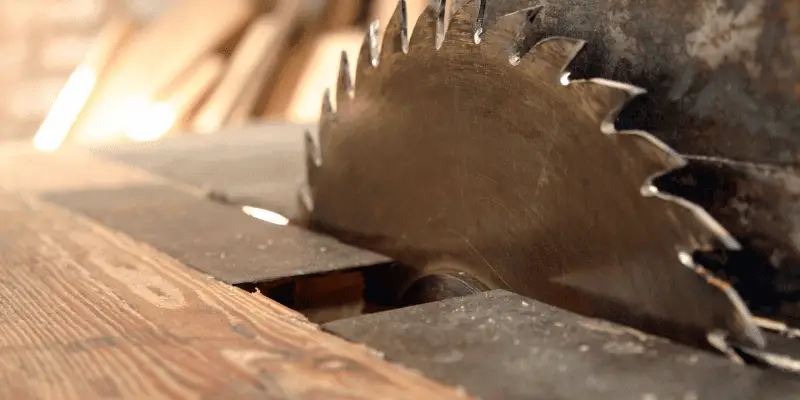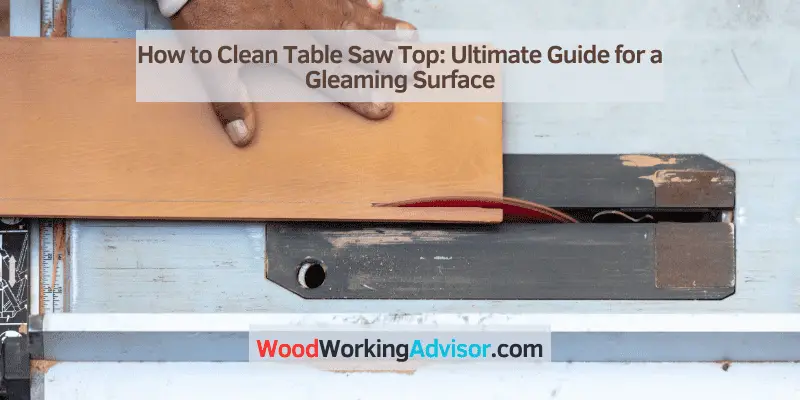To clean a table saw top, first, remove any debris using a vacuum or compressed air, then wipe it down with a clean cloth and a mild solvent to remove any stubborn residue. Ensure to regularly clean and maintain your table saw top to ensure its longevity and optimal performance.
Having a clean table saw top is essential for achieving precise and safe cuts. Regular cleaning also prevents the build-up of sawdust and other debris, which can affect the accuracy of your cuts and potentially damage the surface of your saw.
By following a few simple steps, you can easily maintain your table saw top and ensure it performs at its best. We will provide you with practical tips and techniques for effectively cleaning your table saw top to keep it in top condition.

The Ultimate Guide For A Gleaming Table Saw Top
Keeping your table saw top clean is essential for optimal performance and longevity of the tool. A gleaming table saw top ensures smooth and precise cuts, protects the material being cut, and reduces the risk of rust and corrosion. In this ultimate guide, we’ll walk you through the process of recognizing when it’s time for a cleanup and gathering the necessary cleaning supplies to maintain your table saw top in top-notch condition.
Recognizing When It’s Time For A Cleanup
Over time, dust, debris, and residue from woodwork can accumulate on the table saw top, affecting the accuracy and safety of your cuts. Here are the signs that indicate it’s time for a thorough cleanup:
- Visible buildup of sawdust and debris
- Rough or uneven surface causing friction
- Difficulty in sliding workpieces smoothly
- Presence of rust spots or discoloration
Gathering Necessary Cleaning Supplies
Before you begin cleaning the table saw top, gather the following supplies to ensure a thorough and effective cleaning process:
- Microfiber cloths
- Mild detergent or specific saw table cleaner
- Mineral spirits or rust remover (if there are rust spots)
- Soft-bristled brush or nylon scouring pad
- Clean rags for drying
- Rubber gloves for protection
Pre-cleaning Preparations
Before diving into the process of cleaning your table saw top, it’s crucial to prepare and ensure safety measures are in place. This helps to streamline the cleaning process and mitigates any potential risks during the operation. In this section, we’ll discuss how to ensure safety first and the importance of pre-cleaning inspection and initial dust removal.
Ensuring Safety First
Prior to cleaning the table saw top, it’s vital to prioritize safety. This involves turning off the power and unplugging the table saw to prevent any accidental start-ups. Additionally, wearing appropriate safety gear such as goggles, gloves, and a dust mask is essential to protect yourself from potential hazards during the cleaning process.
Pre-cleaning Inspection & Initial Dust Removal
Conducting a thorough pre-cleaning inspection of the table saw top is crucial. Check for any debris, sawdust buildup, or potential hazards that could impede the cleaning process. Use a brush or a vacuum with a soft brush attachment to remove the initial layer of dust and debris from the top. This will make the subsequent cleaning more effective and prevent any contaminants from hindering the process.
Suggested Cleaning Techniques
When it comes to maintaining your table saw, keeping the top clean is crucial for ensuring optimal performance and longevity. Proper cleaning not only helps to prevent rust and corrosion but also ensures accurate cuts. In this section, we will discuss the suggested cleaning techniques for your table saw top, focusing on choosing the right cleaners and the step-by-step cleaning process.
Choosing The Right Cleaners
When selecting cleaners for your table saw top, it’s important to choose products that are specifically designed for removing sawdust, dirt, and grease while protecting the surface. Opt for non-abrasive cleaners that won’t damage the table saw top. Additionally, consider using biodegradable cleaners to minimize environmental impact. Always check the manufacturer’s recommendations for approved cleaning products to avoid voiding warranties or causing damage.
Step-by-step Cleaning Process
Follow these steps to effectively clean your table saw top:
- Prepare the surface: Before cleaning, unplug the table saw to ensure safety. Remove any debris or sawdust using a brush or vacuum cleaner with a soft brush attachment.
- Apply the cleaner: Spray the chosen cleaner onto the table saw top, ensuring even coverage. Allow the cleaner to sit for a few minutes to loosen stubborn grime.
- Scrub the surface: Use a non-abrasive scrub pad or sponge to gently scrub the table saw top, focusing on areas with built-up residue.
- Wipe clean: Use a clean, lint-free cloth to wipe away the cleaner and any loosened debris. Repeat this step as necessary until the surface is clean.
- Dry the surface: Ensure the table saw top is completely dry using a separate dry cloth to prevent rust formation.
- Apply protectant (optional): If recommended by the manufacturer, apply a thin coat of protectant to the table saw top to prevent rust and corrosion. Follow the manufacturer’s instructions for the specific protectant being used.
How To Clean Rust From Saw Top
Rust on a table saw top can hinder its performance and affect the precision of your cuts. Effectively removing rust is essential to maintaining the functionality and longevity of your table saw. Here, we will take you through the process of identifying different types of rust and selecting the appropriate rust removal methods.
Identifying Types Of Rust
Before diving into the cleaning process, it’s important to identify the type of rust present on your table saw top. The two main types of rust commonly encountered are:
- Surface rust: Superficial rust that can be easily removed with basic cleaning methods.
- Deep rust: Heavily pitted and stubborn rust that requires more intensive treatment for removal.
Selecting Rust Removal Methods
Based on the type of rust identified, you can choose the most suitable method for optimal rust removal. Here are some effective rust removal techniques:
| Rust Type | Rust Removal Method |
|---|---|
| Surface rust | 1. Use a mild abrasive cleaner and a non-abrasive scrubbing pad to gently scrub the affected areas. 2. Apply a rust remover solution and scrub with a nylon brush. |
| Deep rust | 1. Use a wire brush or sandpaper to remove the loose rust. 2. Apply a rust converter to transform the remaining rust into a stable, protective coating. |
Always follow the manufacturer’s instructions when using any chemical products and wear appropriate protective gear.
Maintaining A Sparkling Saw Surface
Keeping your table saw top clean is essential for the efficiency and longevity of the tool. Leverage these expert tips to maintain a sparkling saw surface and ensure optimal performance.
Routine Maintenance Tips
Cleaning the table saw top regularly will help prevent the buildup of debris, sawdust, and other particles that can affect the saw’s performance. Here are some routine maintenance tips:
- After each use, wipe down the table saw top with a clean, dry cloth to remove any sawdust, dirt, and residue.
- Use a mild detergent and water solution to clean the surface, ensuring that the detergent is suitable for the material of the table saw top.
- Inspect the table saw top for any signs of rust, corrosion, or damage, and address any issues promptly.
- Apply a thin layer of protective wax or specialized table saw cleaner to the surface to prevent rust and maintain a smooth, clean finish.
Preventing Future Rust And Corrosion
Protecting your table saw top from rust and corrosion is crucial for its durability. Here are some steps to prevent future rust and corrosion:
- Store the table saw in a dry and climate-controlled environment to minimize exposure to moisture and humidity.
- Use rust inhibitors or corrosion-resistant coatings to safeguard the table saw top from environmental elements.
- Regularly inspect and maintain the protective coatings to ensure their effectiveness in preventing rust and corrosion.
- Consider investing in a table saw cover or protective accessories to shield the tool from dust, moisture, and other potential corrosive agents.
Tailored Advice For Different Table Saws
When it comes to maintaining your table saw, ensuring that the top is clean is vital for its performance and longevity. However, different table saw models can require tailored cleaning methods to address specific concerns and variations. By adapting your cleaning approaches, you can effectively maintain the saw top of different models without compromising its functionality.
Addressing Specific Saw Model Concerns
- Cleaning the contractor table saws: While cleaning contractor table saws, pay extra attention to removing sawdust and debris from the trunnions and gears to prevent any build-up that may affect the saw’s performance.
- Maintaining cabinet table saws: For cabinet table saws, focus on the lubrication of the gears and bearings as they are enclosed within the cabinet, requiring specific maintenance attention.
- Care for benchtop table saws: Benchtop table saws require careful cleaning of the blade alignment and checking for any potential corrosion on the table surface due to exposure.
Adapting Cleaning Methods For Saw Top Variations
- Beyond the surface: Regardless of the table saw type, a general practice includes regular inspection of the table surface for any rust or warping. For cast iron tops, using a rust remover and applying protective coatings can help safeguard the surface against corrosion.
- Blade guard adjustments: When cleaning the saw tops, ensure that the blade guard and riving knife are correctly adjusted and free from sawdust accumulation to maintain an effective cutting performance.
- Power tool vacuuming: Utilize the appropriate attachments on a power tool vacuum to reach crevices and corners of the saw top, ensuring thorough removal of sawdust and debris.
Frequently Asked Questions On How To Clean Table Saw Top
How Can I Protect My Table Saw Top From Rusting?
To protect your table saw top from rusting, regularly clean it with a rust remover, apply a protective coating like paste wax or silicone spray, and cover it when not in use. These measures will help prevent rust and maintain the saw’s top in good condition.
What Is The Best Way To Remove Tough Stains From The Table Saw Top?
For tough stains on your table saw top, use a mild abrasive cleaner with a non-abrasive scrub pad or fine steel wool. Gently scrub the stained area in circular motions until the stain lifts. Wipe the surface clean and apply a protective coating after to prevent future stains.
How Often Should I Clean My Table Saw Top?
It’s recommended to clean your table saw top after each use to prevent sawdust and debris buildup. Deep cleaning and maintenance should be done every few months or as needed, depending on usage and environmental factors such as humidity and temperature.
Are There Any Natural Alternatives For Cleaning A Table Saw Top?
Yes, you can use natural alternatives like vinegar and baking soda to clean your table saw top. Create a paste using baking soda and water, apply it to the surface, and scrub gently to remove dirt and stains. Vinegar can be used to tackle tougher stains and rust.
Always rinse and dry the surface thoroughly after cleaning.
Conclusion
To keep your table saw top in top condition and ensure accurate cuts, regular cleaning is key. By following the simple steps outlined in this guide, you can easily remove rust, debris, and stains while protecting the surface from future damage.
With patience and dedication, maintaining your table saw top will extend its lifespan and performance, allowing you to tackle projects with precision and confidence.



2 thoughts on “How to Clean Table Saw Top: Ultimate Guide for a Gleaming Surface”